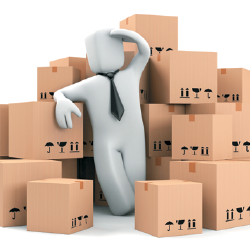 |
 Candy Adams,
Candy Adams,
CTSM, CME,
CEM, CMP, CMM,
is an independent exhibit-management
consultant, trainer, speaker, writer, and an Exhibitor conference
faculty member.
CandyAdams
@BoothMom.com
|
| |
 ot too long ago, I needed to get my booth from a show in Minneapolis to another show in Chicago overnight. I had secured an approved off-target inbound time from show management, in writing, for early the next morning. When my truck driver checked in with me in Minneapolis to load the truck, I asked him where he'd be getting the certified weight slip for the load, if he had the map to the marshaling yard that I had provided, and if he brought a copy of the off-target letter from show management. He had no idea what I was talking about. ot too long ago, I needed to get my booth from a show in Minneapolis to another show in Chicago overnight. I had secured an approved off-target inbound time from show management, in writing, for early the next morning. When my truck driver checked in with me in Minneapolis to load the truck, I asked him where he'd be getting the certified weight slip for the load, if he had the map to the marshaling yard that I had provided, and if he brought a copy of the off-target letter from show management. He had no idea what I was talking about.
It turns out that my driver was a rookie and had never driven in snow before that day. He didn't have the $10 required for the certified weight slip, and he hadn't had any sleep in the last 24 hours. I gave him cash for the weight slip, another copy of the map to the marshaling yard, the off-target permission slip, and a cup of coffee and sent him on his way.
My rookie driver made it to the marshaling yard just before dawn, but he fell asleep and missed the deadline to turn in his paperwork at the yard's check-in trailer, putting him at the end of the line to unload, and throwing our setup into overtime. Fortunately, the van line paid for the overtime labor when I explained the situation.
As this story demonstrates, the cost of trade show transportation is complicated. In addition to the expense of shipping your exhibit to and from a show, the timing of your shipment impacts other show services such as material handling and installation. So here are 10 tips to help you keep transportation costs under control.
1. Find out who's driving.
According to some estimates, freight volume to trade shows was down by about 30 percent in 2009, presumably due to a decrease in both the number of exhibitors and the size of exhibits. In response to this volume loss, many carriers are subcontracting freight to carriers that don't specialize in trade show freight - without you knowing it. Drivers in these subcontracted fleets may not understand why a weight slip is needed, or that they might need to wait in a marshaling yard for hours to unload.
Ask your carrier if its trucks and drivers will be handling your freight for the entire line haul or if it will be subcontracting the job. If you're not familiar with any carriers to whom it's subcontracting, do some research to make sure that they have drivers trained in the nuances of trade shows.
Your best bet is to select a carrier with a dedicated trade show division such as Mayflower Transit LLC, United Van Lines LLC, Airways Freight Corp., Allied Van Lines Inc., Specialized Transportation Inc. (STI), Bekins Van Lines LLC, Elitexpo Cargo Systems, etc. Trucks are trucks, but the safety and success of your shipment depends on the commitment of your driver to deliver your shipment safely, with the correct paperwork, and on time to the marshaling yard or dock.
2. Contract transportation yourself.
Exhibit houses generally levy a surcharge of 25 to 30 percent of your shipping cost as a turnkey fee for managing transportation. The most cost-effective choice is to arrange it yourself. However, if you do decide to contract with your exhibit house, make sure it's working on your behalf to get competitive quotes from at least three specialized trade show carriers and passing on the standard discounts it's negotiated with them.
I have witnessed exhibit houses negotiate discounts with a carrier (without passing the savings on to their clients) and then add their 25- to 30-percent turnkey fee to the nondiscounted, full-tariff quote from the carrier. This can effectively double the cost of your show shipments when compared to the cost of making your own transportation arrangements.
3. Stack freight.
One of my clients had always used two common-carrier trailers to ship freight to her big annual trade show - one filled with computer equipment and one loaded with a rental exhibit. Then she decided to use a van line instead of a common carrier so she could stack the crates instead of floor loading them (common and expedited carriers do not stack freight). This allowed her to consolidate all of her freight in one trailer and save thousands of dollars, even after considering the higher material-handling rate for stacked freight.
Ask your van-line rep to sketch your exhibit properties in various configurations to show you how they can most efficiently fit in a trailer, since rates are based on either minimum dimensional weight or linear feet. Also negotiate to have your carrier round down (not up) on your dimensional weight to compute your cost, unless you're close to what's known as a "break point," where the price per pound drops based on increased volume.
4. Ask for discounts.
Leverage other corporate shipping arrangements (employee relocation, product shipments, etc.) to obtain volume discounts from your carrier. Work with your carrier to secure discounts on a long-term basis by signing a unilateral contract for both interstate and intrastate shipments to guarantee a fixed discount on shipments regardless of their destination. One expedited freight carrier I recently worked with agreed to waive the fuel surcharges on my clients' shipments because of my long-term loyalty. It never hurts to ask.
5. Plan a road tour.
Instead of shipping to and from each show separately, look at the big picture to see when it makes financial sense to ship your exhibit properties back to your exhibit house, and when it makes more sense to ship them directly to your next show site and store them there until you need them next. Review your schedule with your carrier, using a matrix that includes your show cities and what properties are needed where and when. You can usually store your exhibit at an advance warehouse for your next show for free for 30 days before the show. If you need to store it longer, ask your carrier if it is affiliated with a local storage company that can accommodate your freight.
6. Buy another exhibit.
This may sound counterintuitive financially, but if you do a large volume of shows in two or more regions, it may cost less to own two exhibits and keep them local rather than shipping one exhibit back and forth across the country. For example, you may want to own one exhibit on the West Coast and one on the East Coast, storing each in its respective region.
7. Consolidate small boxes.
Most shows have a minimum material-handling weight, anywhere from 100 pounds (1 CWT, or hundredweight) to 300 pounds (3 CWT). Each individual box that arrives at show site by small-package carrier (e.g., FedEx or UPS) without a bill of lading can be charged the material-handling minimum. For example, if a show charges $100 per CWT and has a minimum of 2 CWT, material-handling fees for a 5-pound box would be $200.
If you don't have crates for shipping your giveaways, literature, etc., you can purchase "D containers" (palletized boxes) for about $50 each. These containers (which look like oversized copier-paper boxes on pallets with lids on both the top and bottom) can be efficiently stacked or fit side by side in a van-line trailer. They also conceal and protect your valuable exhibit materials.
8. Ship to your hotel.
If you can't consolidate boxes or you have last-minute shipments, it is usually less expensive to ship to your hotel business center or a local FedEx office to avoid paying material-handling minimums. Shipping to your hotel can also save time, since small-package freight shipped to the convention center has to be weighed, and inbound material-handling forms have to be written, which can delay delivery to your booth by anywhere from a few hours up to a full day.
9. Make sure your driver is on time.
If your driver misses your inbound target time or does not have a current certified weight slip, charges can add up quickly. In addition to material-handling penalties from the general services contractor (GSC) for being late (up to 25 percent of your total material-handling invoice), your truck will be sent to the end of the line to unload, which can start a domino effect of detention charges, overtime material-handling fees, and overtime installation charges by your installation labor.
10. Audit your show bill.
If you go to the GSC's service desk the day after your freight is unloaded at the show, you can look at the actual certified weight slip that your driver turned in and compare it to your material-handling invoice. The weight slip shows the exact gross weight of the truck with your exhibit in it and the tare weight of your truck before your freight was loaded. The difference between those two numbers is your net weight. Round up your net weight to the nearest hundred pounds and make sure your GSC charged you for the correct amount.
Don't forget to check the material-handling portion of your invoice from the GSC, too, to make sure that you were charged the correct rate per CWT for the type of shipment (special handling versus floor-loaded/crated) and if any additional charges such as overtime or off-target fees were added to your bill. If they were, ask for documentation and photos to back up these charges and determine if any of them were the fault of your transportation carrier, who should then take financial responsibility for them.
By vigilantly monitoring every step of the shipping process, you can keep your shipment on schedule, avoid a domino-effect of overtime charges, and ultimately save thousands of dollars in transportation costs.e
|





 ot too long ago, I needed to get my booth from a show in Minneapolis to another show in Chicago overnight. I had secured an approved off-target inbound time from show management, in writing, for early the next morning. When my truck driver checked in with me in Minneapolis to load the truck, I asked him where he'd be getting the certified weight slip for the load, if he had the map to the marshaling yard that I had provided, and if he brought a copy of the off-target letter from show management. He had no idea what I was talking about.
ot too long ago, I needed to get my booth from a show in Minneapolis to another show in Chicago overnight. I had secured an approved off-target inbound time from show management, in writing, for early the next morning. When my truck driver checked in with me in Minneapolis to load the truck, I asked him where he'd be getting the certified weight slip for the load, if he had the map to the marshaling yard that I had provided, and if he brought a copy of the off-target letter from show management. He had no idea what I was talking about. 


